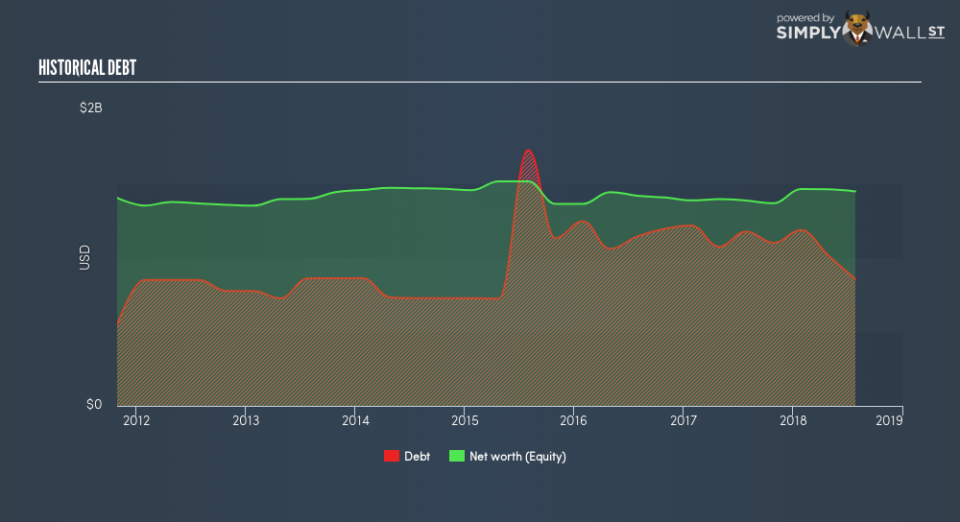How Financially Strong Is Patterson Companies Inc (NASDAQ:PDCO)?

Small-cap and large-cap companies receive a lot of attention from investors, but mid-cap stocks like Patterson Companies Inc (NASDAQ:PDCO), with a market cap of US$2.30b, are often out of the spotlight. While they are less talked about as an investment category, mid-cap risk-adjusted returns have generally been better than more commonly focused stocks that fall into the small- or large-cap categories. Today we will look at PDCO’s financial liquidity and debt levels, which are strong indicators for whether the company can weather economic downturns or fund strategic acquisitions for future growth. Remember this is a very top-level look that focuses exclusively on financial health, so I recommend a deeper analysis into PDCO here.
See our latest analysis for Patterson Companies
Does PDCO produce enough cash relative to debt?
Over the past year, PDCO has reduced its debt from US$1.18b to US$855.6m , which is made up of current and long term debt. With this debt repayment, the current cash and short-term investment levels stands at US$91.5m , ready to deploy into the business. Moreover, PDCO has generated US$430.4m in operating cash flow during the same period of time, resulting in an operating cash to total debt ratio of 50.3%, indicating that PDCO’s current level of operating cash is high enough to cover debt. This ratio can also be interpreted as a measure of efficiency as an alternative to return on assets. In PDCO’s case, it is able to generate 0.5x cash from its debt capital.
Does PDCO’s liquid assets cover its short-term commitments?
With current liabilities at US$917.3m, it seems that the business has maintained a safe level of current assets to meet its obligations, with the current ratio last standing at 1.79x. Generally, for Healthcare companies, this is a reasonable ratio since there’s sufficient cash cushion without leaving too much capital idle or in low-earning investments.
Is PDCO’s debt level acceptable?
PDCO is a relatively highly levered company with a debt-to-equity of 59.1%. This is not uncommon for a mid-cap company given that debt tends to be lower-cost and at times, more accessible. We can check to see whether PDCO is able to meet its debt obligations by looking at the net interest coverage ratio. A company generating earnings before interest and tax (EBIT) at least three times its net interest payments is considered financially sound. In PDCO’s, case, the ratio of 3.58x suggests that interest is appropriately covered, which means that lenders may be less hesitant to lend out more funding as PDCO’s high interest coverage is seen as responsible and safe practice.
Next Steps:
PDCO’s high cash coverage means that, although its debt levels are high, the company is able to utilise its borrowings efficiently in order to generate cash flow. Since there is also no concerns around PDCO’s liquidity needs, this may be its optimal capital structure for the time being. Keep in mind I haven’t considered other factors such as how PDCO has been performing in the past. You should continue to research Patterson Companies to get a more holistic view of the mid-cap by looking at:
Future Outlook: What are well-informed industry analysts predicting for PDCO’s future growth? Take a look at our free research report of analyst consensus for PDCO’s outlook.
Valuation: What is PDCO worth today? Is the stock undervalued, even when its growth outlook is factored into its intrinsic value? The intrinsic value infographic in our free research report helps visualize whether PDCO is currently mispriced by the market.
Other High-Performing Stocks: Are there other stocks that provide better prospects with proven track records? Explore our free list of these great stocks here.
To help readers see past the short term volatility of the financial market, we aim to bring you a long-term focused research analysis purely driven by fundamental data. Note that our analysis does not factor in the latest price-sensitive company announcements.
The author is an independent contributor and at the time of publication had no position in the stocks mentioned. For errors that warrant correction please contact the editor at editorial-team@simplywallst.com.

 Yahoo Movies
Yahoo Movies 

